Discover the best retrospective techniques that help to identify what worked well, what didn’t, and where to make improvements, to support your team in their journey toward greater cohesion and productivity.
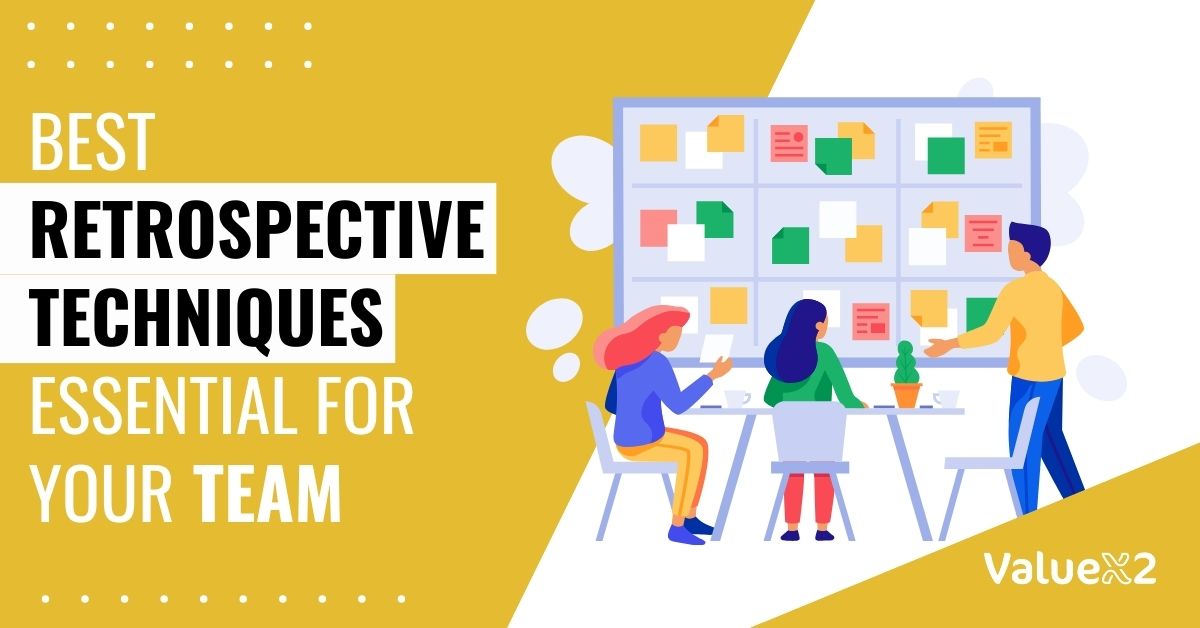
Introduction
We know that in any environment where teamwork is required, there is always a need to enhance achievements constantly. Modern teams require a set of mechanisms to discuss their strategies, successes, and failures. A retrospective meeting, or ‘retros’ for short, is one way of figuring out what has gone well and what might be going better.
Based on and held at the end of a project, a sprint, or an iteration, retrospectives allow team members to express feedback, improvements or shifts, and improve coordination and cohesiveness. Self-reflection can improve the productivity and morale of employees, leading to improved outcomes and organisational culture.
This guide defines retrospectives, gives a detailed process of how you can perform your retro session effectively, and presents a few of the best practices for retrospectives. If you are an experienced Agile team that is using retrospectives or if you are new to the concept, we have these techniques to improve learning act, increase collaboration and help your team explore new heights.
What is a Retrospective?
Looking back at events or the work done is known as a retrospective. In the corporate world, the retrospective is a meeting where you gather with a development team to discuss the last sprint. The purpose is to perform an internal audit, find out where we can make improvements and then devise a strategy on how that change can be effective.
The last sprint we are referring to here is the last one week, two weeks or one month of work. The meeting mainly addresses three things:
- What actions would you start?
- What actions would you stop?
- And, what actions would you continue doing?
These three questions can take various forms but it all boils down to two things – what went well, and what can be improved.
How to do a retrospective?
A retrospective is an important procedure for managing Agile projects as it helps the team to analyze workflow, share appreciation, and identify enhancements. This is quite efficient as it enhances the teams’ performance and increases team cohesion. Below is a step-by-step guide to get the best experience from a retrospective:
1. Set the Stage
To start with, one should create a secure and permissive atmosphere. Let every member of the team express and share ideas without having to worry about criticism. Begin with a brief warm-up so no one feels uncomfortable speaking out their thoughts at the beginning of the exercise.
2. Gather Data
The next step is to gather information from the team. Then, you can use effective retrospective methods like “Start, Stop, Continue” where the team understands what things should be stopped, started and continued.
3. Generate Insights
Now learn more about the gathered data. Use the five why analysis to get to the source of a problem. This is where best practices for retrospectives come into effect. Ask the team to look for patterns or the same problem recurring and have them talk to the rest of the team about how it affects them.
4. Decide on Action Items
Select the best retrospective techniques that would help in finding out valuable learnings. Choose one to three measurable actions the team should take in the next cycle. Do not overcrowd the meeting with too many action points else everyone will feel overwhelmed. Ideally, pursue two to three specific, actionable and positive steps.
5. Close the Retrospective
End the meeting on a positive note. It’s important to end on a positive note so every person can walk away from the meeting motivated and with a feeling that they are important.
Additional Tips
It is recommended to opt for something immediate, such as sticky notes, whiteboards or any online source that will make the process more appealing. Maintaining the retrospectives regularly, short and concentrating on one or two topics is the best way over time.
By following these steps and applying the best retrospective techniques you can continuously enhance team performance and make every cycle of a project more effective.
Who does retrospectives?
Retrospectives, in an organization, are typically conducted by the Scrum Master. Within an Agile team, a Scrum Master plays an important role in developing a culture of continuous improvement. A Scrum Master guides the team on the processes and outcomes, ensuring that the team can identify areas for improvement. If you are a professional and want to upskill as a certified Scrum Master, then ValueX2’s dedicated certifications like SAFe Scrum Master (SSM) or Professional Scrum Master (PSM I or PSM II) can allow you to enhance your career. With these certifications (SSM or PSM I / PSM II), you not only get a deeper understanding of Agile frameworks but also get access to practical tools to facilitate retrospectives effectively and ensure the overall success of your team.
Best Retrospective Techniques Your Team Needs to Adopt
Various techniques can be employed to conduct the meeting to make the retrospectives more fun and interesting. Let us look at some of the best retrospective techniques you can use to enhance the overall performance of your team:
Start-Stop-Continue Technique
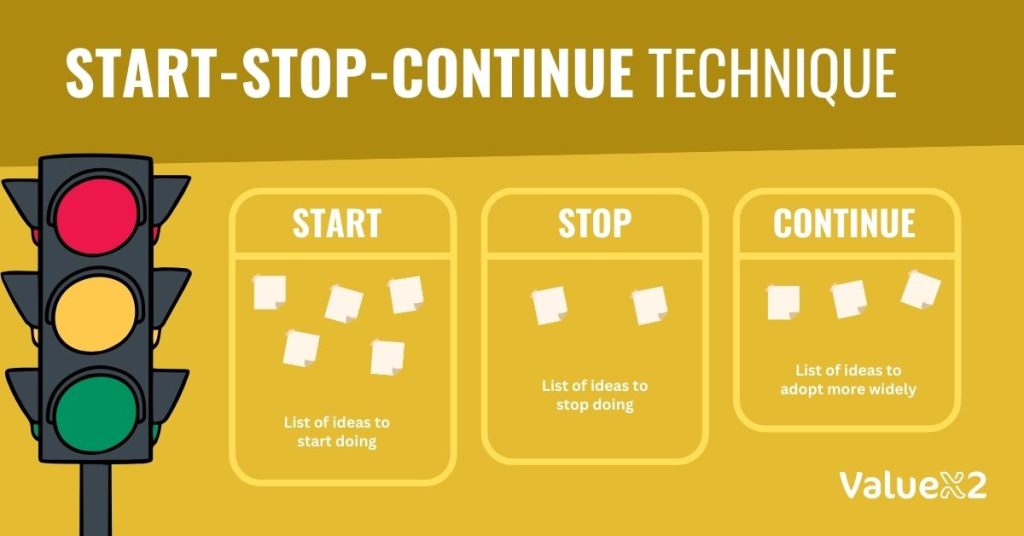
In this technique, most of the team will answer 3 questions in the retrospective meeting. The questions are:
- What are the things that went well?
- What are the things that did not go well?
- Are there actions which can be improved?
You can also create a board with 3 titles start, stop and continue. The start section is to note the activities that the team will start performing from the next sprint. The stop section is to note the activities that the team should stop doing. The continue section is to note the good activities done in the past which the team can also continue doing in future sprints.
The Sailboat Technique
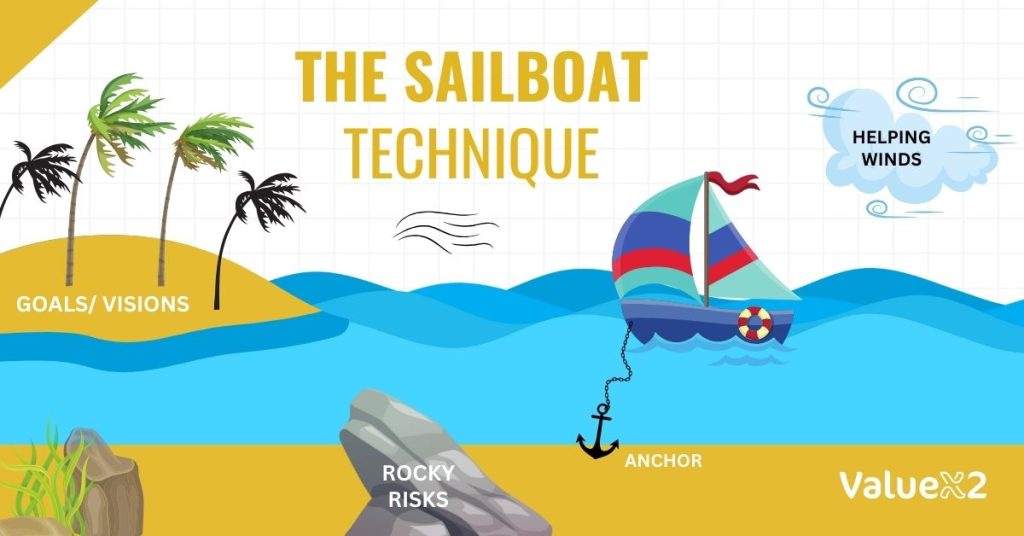
It is a solution-focused thinking technique using the visualization tool. A team can draw a sailboat on the board with various elements like wind, anchor, rocks, and sun.
- Wind represents the things that push the team forward.
- Rocks under the water represent the dangerous stuff that might sink the team. Risks might be categorised under this section
- Anchor represents the things that are slowing the team down or presenting obstacles for the team.
- Sun represents the things the team appreciates.
The team can collectively represent their ideas on a digital board. Identify certain actions that can be categorised as the rocks and the anchor, which can be taken care of in future sprints. After collecting all the ideas, the team can prioritise and identify an action plan for further improvements.
Mad-Sad-Glad Technique
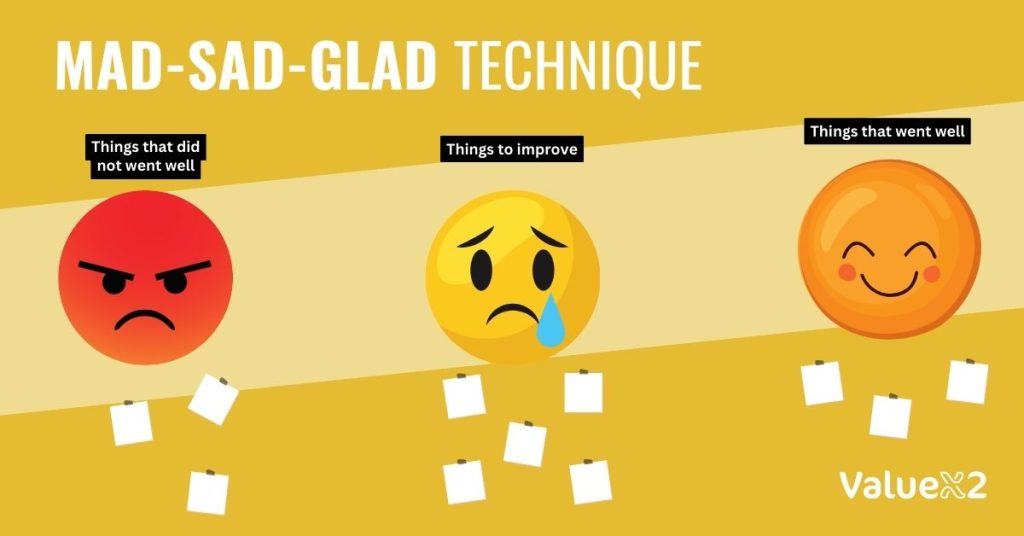
The Mad-Sad-Glad is another one of the best retrospective techniques. It encourages the team to be more emotionally aware to build a positive team dynamic. It also provides an opportunity to reflect on issues from a different perspective.
- Mad represents the things that are stopping the team from performing their best.
- Sad represents the things that have disappointed the team or things that can be improved.
- Glad are the things that make the team happy.
The team can discuss and prioritise the improvement actions based on the collected data.
4L (Liked, Learned, Lacked, Longed for) Technique
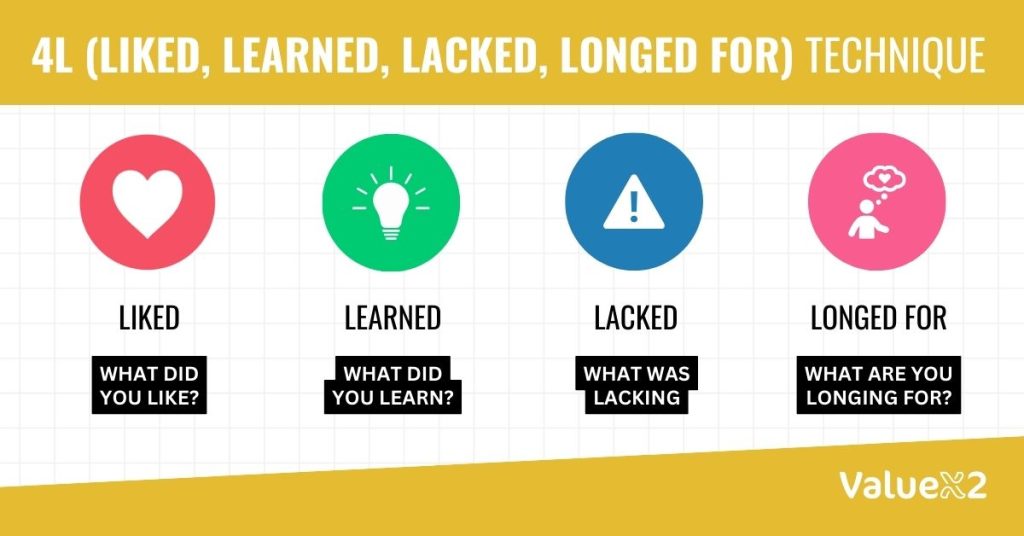
4L Technique is one of the effective and best retrospective techniques that helps the team to reflect on their performance and take measures to improve it. In this technique, you can ask your team to write their ideas based on the four categories:
- Liked – Things that the team likes
- Learned – Things the team has learned from the sprint
- Lacked – Things the team can do better or improve
- Longed For – Things the team desires or wishes for
Then facilitate a discussion based on those ideas.
Star Fish Technique
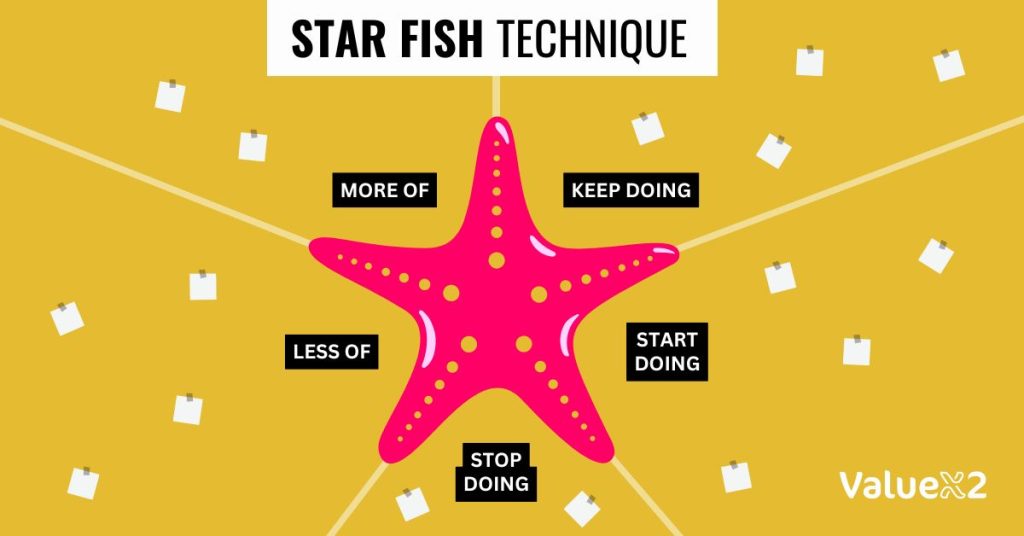
Star Fish technique is a data-gathering activity to foster thinking around best practices and value addition. This technique helps the members to understand each other’s perceptions about the practices of the organisation. Five sections should be created in the Star Fish format:
- Keep doing – The things that the team is doing well and acknowledging the value addition.
- Less of – The things that have already been done but only add a little value.
- More of – The things that are being done which add more value.
- Stop doing – The things that do not add any value.
- Start doing – Implement a new idea or something that the team is exploring that they want to bring to the table.
KALM Technique
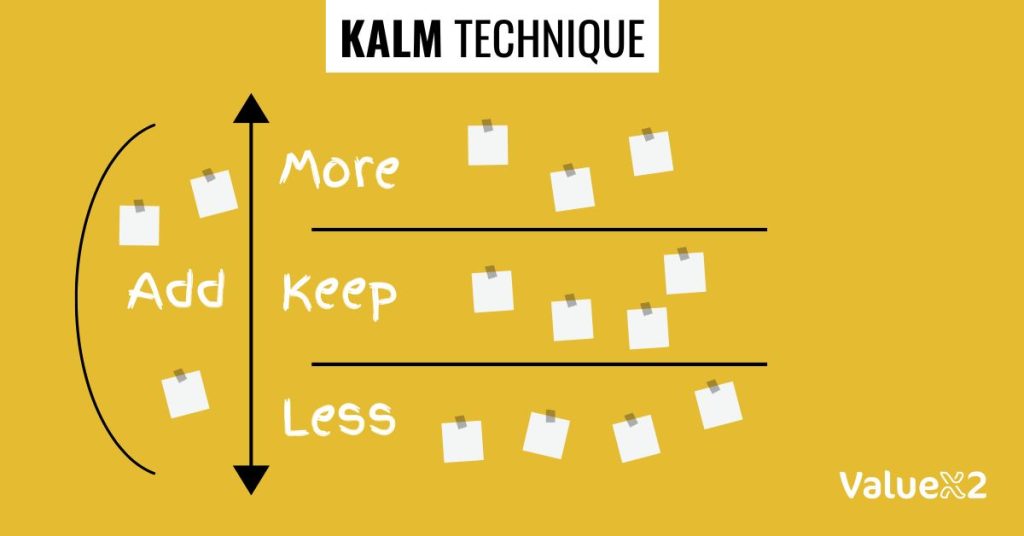
In this retrospective technique, you will divide your whiteboard into 4 columns – Keep, Add, Less, and More. You and your team will address your previous sprint and come up with different ideas and observations that are suitable and can be placed on the board.
- Keep – Things the team should continue doing
- Add – Things that the team should incorporate in the next sprint
- Less – Things that do not add much or any value to your team should be removed
- More – Things that add value to your team should be done more
Best Practices for Retrospectives Essential for Your Team
Retrospectives are effective in enabling people to reflect, understand different experiences and enhance learning on projects. Retrospective should be organised in a way that enhances collaboration with colleagues, identifies the positive aspects, and establishes the issues to be addressed. Here are 7 best practices for retrospectives you can adopt to improve your team efficiency:
Plan the Retrospectives
If you do not plan correctly, you will not find the retrospective to be effective. Conduct the retrospectives weekly, bi-weekly, or monthly depending on the pace of your project. The planning of the sessions allows team members to get ready mentally. The awareness of when the next retrospective is going to occur makes it a smooth process for the team.
Choose a suitable time, which enables the group to cover the material but not take too long otherwise the session turns into a worthless exercise. A range of 30-60 minutes appears to be effective in allowing the team to have time to work out something on their own but not too long to lose attention.
Prepare Minds
Get all participants ready and motivated before a retrospective session. This means that people should focus on the situation and not point fingers at each other i.e. the team should be more reflective. One of the ways minds are prepared is by issuing questions to the intended targets.
For instance, when you ask ‘What went well this sprint?’ or ‘What more can we do ?’ Such questions can help your team to think constructively about the objectives of the session. Rewarding candour is important for ascertaining the real areas that need improvement.
Press Play
After everyone is prepared it is important to set a constructive mood in the session. One has to start with setting recognition of the commendable performances and achievements of the particular team no matter how small they may be.
Stating some positives first sets the tone of the meeting as positive, which ensures that the respondents respond positively when the negatives are initiated. For example, use a few minutes to discuss the successes that were made in the previous sprint or the project phase, and emphasize what the team got right.
Play Data Generating Games
Data-generating games are highly useful in involving a team and making retrospective meetings more entertaining. Such activities foster the contribution of ideas and even input of views by all people in a novel way. For example, one may speak about “Mad, Sad, Glad,” an effective retrospective method by which members write down the things that make them want to express a particular emotion.
Another game used is known as Start, Stop, Continue which will make the team make a list of those things that they should start doing, should stop doing and those they should continue doing. Applying this kind of activity also enables the collection of a diversity of opinions and fuels the conversation. When it comes to generating data you may use visuals, sticky notes, or some of the best collaboration tools if you’re a remote team.
Perform Analysis
After the data has been collected analyze it to be able to see some form of pattern or similar occurences. It is possible to try to group similar insights for such insights as they unite making it possible to outline greater areas for improvement. For example, it may be possible that when several people raise complaints about communication, there may be a need for more frequent reports or possibly well-defined roles.
Give people the opportunity to share something they have noticed and do not scold them forcing others to remain silent. By analysing facts and results of working instead of voicing attitudes, the team can be more unbiased.
Prioritise Actions
After the identification of insights, you can determine what particular actions should be taken. These actions should work on solving the big problems since smaller problems can be solved independently alone without improving much.
It is necessary to determine what success looks like for each of the actions. For instance, if enhancing group cooperation is an objective, then, create a goal, like starting a weekly online conference. You can prevent misunderstandings if you clearly outline what you expect the team to perform when a particular action is taken.
Pursue Outcomes
The worst thing a team can do is come up with a vibrant retrospective and, later, forget all the action items. Ensure that you assign the tasks properly. Put names on every action concerning who will be accountable for carrying out the plan and following up on the progress.
Ensure that these action items remain in full sight to the team, perhaps in a shared Google document, or in the project management tool, to show everyone what has been accomplished.
Finally, checking what went well and what didn’t is vital to focus on at the next session. One benefit is that the “inspect and adapt” approach always reinforces continuous improvement in the long-term vision, and culture of the team.
Conclusion
A retrospective is a powerful process that allows a team not only to look at their accomplishments but also their potential flaws. When organized effectively, such meetings encourage discussion and provide an environment where every member of the team will have the opportunity to be valued.
When you follow techniques like Start-Stop-Continue, Sailboat, or Mad-Sad-Glad, and all the best practices for retrospectives, useful insights and fancy goals emerge that help in the organization’s growth and foster collaboration. A retrospective strengthens team integration, promotes constant enhancement, and ensures the team remains future-oriented, improving in the long run.
The use of the best retrospective techniques in the given organizational culture assists the team in enhancing their productivity while offering a structure to everybody and guaranteeing the efficiency of constructive changes.
Frequently Asked Questions (FAQs)
Q. What is the best approach for running an effective retrospective?
Ans. The most effective retrospective method includes providing the team members with a comfortable atmosphere where they will be able to express themselves. Use an icebreaker, like ‘Start, Stop, Continue’ or ‘4Ls’ (Liked, Learned, Lacked, Longed For) to scaffold insights amongst the participants. End the conference with action plans and specific accountability to remain on track.
Q. What is the key to a successful retrospective activity?
Ans. The main focus is to foster a culture of truthful conversation and an organizational culture where no one plays the blame game. Communication is efficient if and only if, the participants can freely put forward their opinions and ideas. Other aspects contributing to success are speaking of tangible advancements, controlling the outcomes of previous work, and making sure there is a consensus on new measures to make the team faster.
Q. What are the elements of a good retrospective?
Ans. The elements which should be followed to have a good retrospective are as follows: proper start, presence of agenda, everybody involved, and feedback. These include utilization of tools or frameworks to get insights, moderation and last and most importantly, identification of tactful items to achieve. End the meeting with an appropriate call-to-action to the relevant teams, so that improvement becomes perpetual.
Q. What are the 3 questions that can be asked during a retrospective?
Ans. The three common questions are:
What went well? – To discover best practices.
What can we improve? – To define the various problem areas of a learning organization.
What can we do differently the next time? – To generate new strategies in an attempt to achieve improved outcomes.
These questions help drive contemplation, growth, and subsequent, practical strategies.
Q. What is the agile way of working a retrospective?
Ans. In Agile, there are several mini-session retrospectives. They are short and one can conduct them at the end of every sprint. They are brief, closed-loop communications that consist of reviewing work performed in a previous period, deciding on changes needed, and defining actions for the subsequent sprint. This approach of feedback and feedback loop encourages timeliness in responses and fosters team adaptability across the organizations.

Bhavna is an Agile Coach and Consultant with over a decade of experience in advisory, corporate finance, IT assurance, and operations at Big 4 and within the industry in the UK and India. She has recently been the CEO of a start-up where she implemented agile practices within HR, Marketing, and Product teams.
She is also a SAFe® Practice Consultant (SPC) and authorized instructor for ICAgile Agility in HR (ICP-AHR), Agility in Marketing (ICP-MKG), and Business Agility Foundations (ICP – BAF) training courses. She provides training for agile transformation to corporate, public, and private batches, as well as consulting for enterprise agile transformation.






